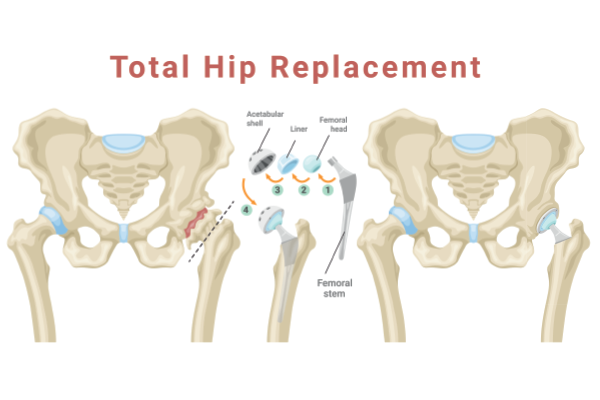
Total hip replacement is a surgical procedure designed to relieve pain and improve function in patients suffering from severe hip joint conditions. It is one of the most successful orthopaedic surgeries, offering long-term relief from chronic pain and mobility issues. This procedure is commonly recommended for individuals suffering from arthritis, fractures, or other degenerative hip diseases that significantly impact their daily lives.
In this blog, we will discuss what hip joint surgery entails, the types of hip implants, the recovery process, and why this procedure is beneficial for individuals seeking hip pain treatment in Ghaziabad.
Synopsis
Understanding the Hip Joint
The hip joint is one of the largest weight-bearing joints in the body. It is a ball-and-socket joint where the femoral head (the ball) fits into the acetabulum (the socket) of the pelvis. A smooth layer of cartilage covers the surfaces of these bones, allowing painless movement. Over time, due to aging, injury, or disease, this cartilage wears away, leading to pain, stiffness, and reduced mobility.
Comparison of Hip Implant Types
|
Implant Type |
Material Used |
Durability |
Best For |
|
Cemented Implants |
Bone cement |
Moderate |
Elderly patients with lower activity levels |
|
Uncemented Implants |
Porous-coated metal |
High |
Younger, active patients |
|
Metal-on-Polyethylene |
Metal & plastic |
Good |
General use, moderate activity levels |
|
Ceramic-on-Ceramic |
Ceramic |
Excellent |
Highly active individuals |
|
Metal-on-Metal |
Metal |
Varies |
Less commonly used due to concerns |
What is Total Hip Replacement?
Total hip replacement (THR), also known as hip arthroplasty, is a surgical procedure that involves replacing the damaged or diseased hip joint with an artificial implant. The goal is to relieve pain, restore function, and improve the patient’s quality of life. The artificial hip implant consists of:
-
A metal or ceramic ball that replaces the femoral head
-
A socket made of plastic, ceramic, or metal that replaces the acetabulum
-
A stem that anchors the implant into the femur

Why is Hip Joint Surgery Needed?
Patients experiencing severe hip pain and stiffness that do not respond to medication, physical therapy, or lifestyle modifications may require hip joint surgery. Some common conditions leading to THR include:
-
Osteoarthritis – Wear and tear of cartilage due to ageing.
-
Rheumatoid arthritis – Inflammatory arthritis leading to joint damage.
-
Hip fractures – Injuries that may not heal properly.
-
Avascular necrosis – Loss of blood supply to the hip bone.
-
Congenital hip dysplasia – A condition where the hip joint does not develop properly.
Types of Hip Implants
The choice of hip implant depends on factors like age, activity level, and the severity of joint damage. The common types include:
1. Cemented vs. Uncemented Implants
-
Cemented implants: Use bone cement to attach the prosthetic components.
-
Uncemented implants: Allow natural bone growth to secure the implant.
2. Metal-on-Polyethylene Implants
A combination of a metal ball and a plastic socket is commonly used due to its durability.
3. Ceramic-on-Ceramic Implants
Offers excellent wear resistance, ideal for younger, more active patients.
4. Metal-on-Metal Implants
Previously popular but now less commonly used due to concerns about metal ions.
The Procedure of Hip Joint Surgery
Pre-Surgery Preparation
-
Comprehensive medical evaluation and imaging tests.
-
Stopping blood-thinning medications if required.
-
Maintaining a healthy weight and following preoperative instructions.
Surgical Procedure
The surgery typically takes 1-2 hours and is performed under general or spinal anaesthesia. The surgeon makes an incision, removes the damaged joint, and places the artificial hip implant securely. The incision is then closed with stitches or staples.
Post-Surgery Recovery
-
Hospital Stay: Patients stay for a few days to monitor healing.
-
Physical Therapy: Begins within a day to restore mobility.
-
Pain Management: Medications help manage post-operative discomfort.
-
Home Care: Avoiding high-impact activities and using assistive devices.
Benefits of Total Hip Replacement
-
Pain Relief: Significant reduction in chronic hip pain.
-
Improved Mobility: Restores the ability to walk and perform daily activities.
-
Enhanced Quality of Life: Patients can return to normal routines.
-
Long-Lasting Results: Modern hip implants last 15-20 years or more.
Know More: Benefits of Total Hip Replacement
Risks and Complications
Like any surgery, hip joint surgery has potential risks, including:
-
Infection at the surgical site.
-
Blood Clots in the legs or lungs.
-
Implant Loosening over time.
-
Hip Dislocation requires repositioning.
-
Nerve or Blood Vessel Damage, though rare.
Conclusion
If you are considering a hip replacement in Ghaziabad, it is crucial to choose an experienced orthopaedic surgeon. Look for a hospital with advanced technology, experienced medical staff, and a strong record of successful hip surgeries.
At Manipal Hospital, we offer world-class hip replacement Ghaziabad services with cutting-edge technology and expert surgeons. Our facilities provide comprehensive pre-and post-operative care, ensuring a smooth recovery process. If you or a loved one are suffering from chronic hip pain, consult with our specialists today to explore the best treatment options available.
FAQ's
Modern hip implants last 15-20 years, depending on activity levels and lifestyle choices.
Modern hip implants last 15-20 years, depending on activity levels and lifestyle choices.
The surgery is performed under anaesthesia, so you won’t feel pain during the procedure. Post-operative pain is managed with medications and physical therapy.
Most patients resume daily activities within 6-12 weeks, but full recovery may take up to a year.
Yes, most patients regain normal walking ability with the help of physical therapy.
Patients are advised to avoid high-impact activities like running or jumping to prolong the life of the implant. For expert hip pain treatment Ghaziabad, visit Manipal Hospital today and take the first step toward a pain-free life!



















 5 Min Read
5 Min Read













